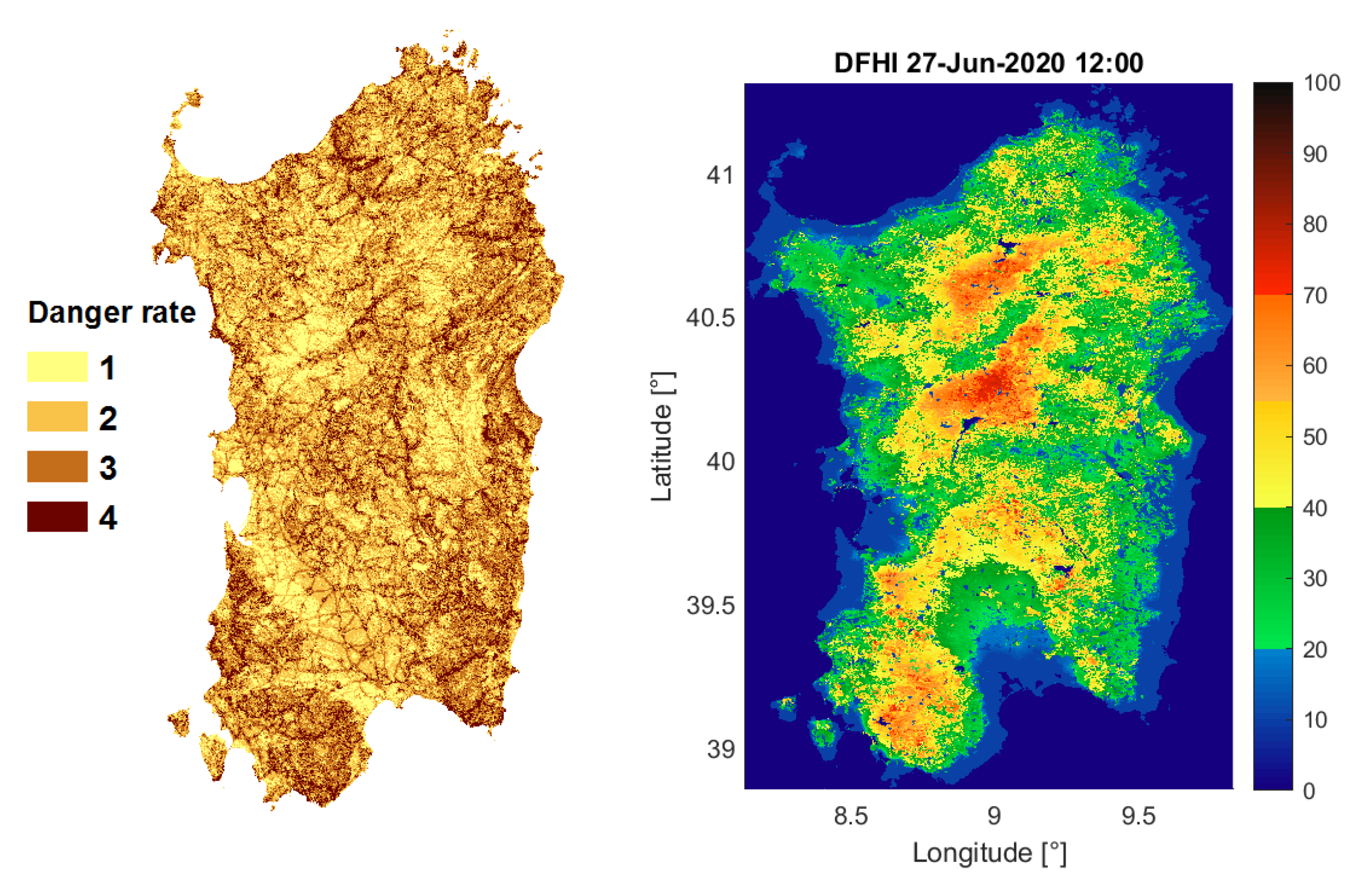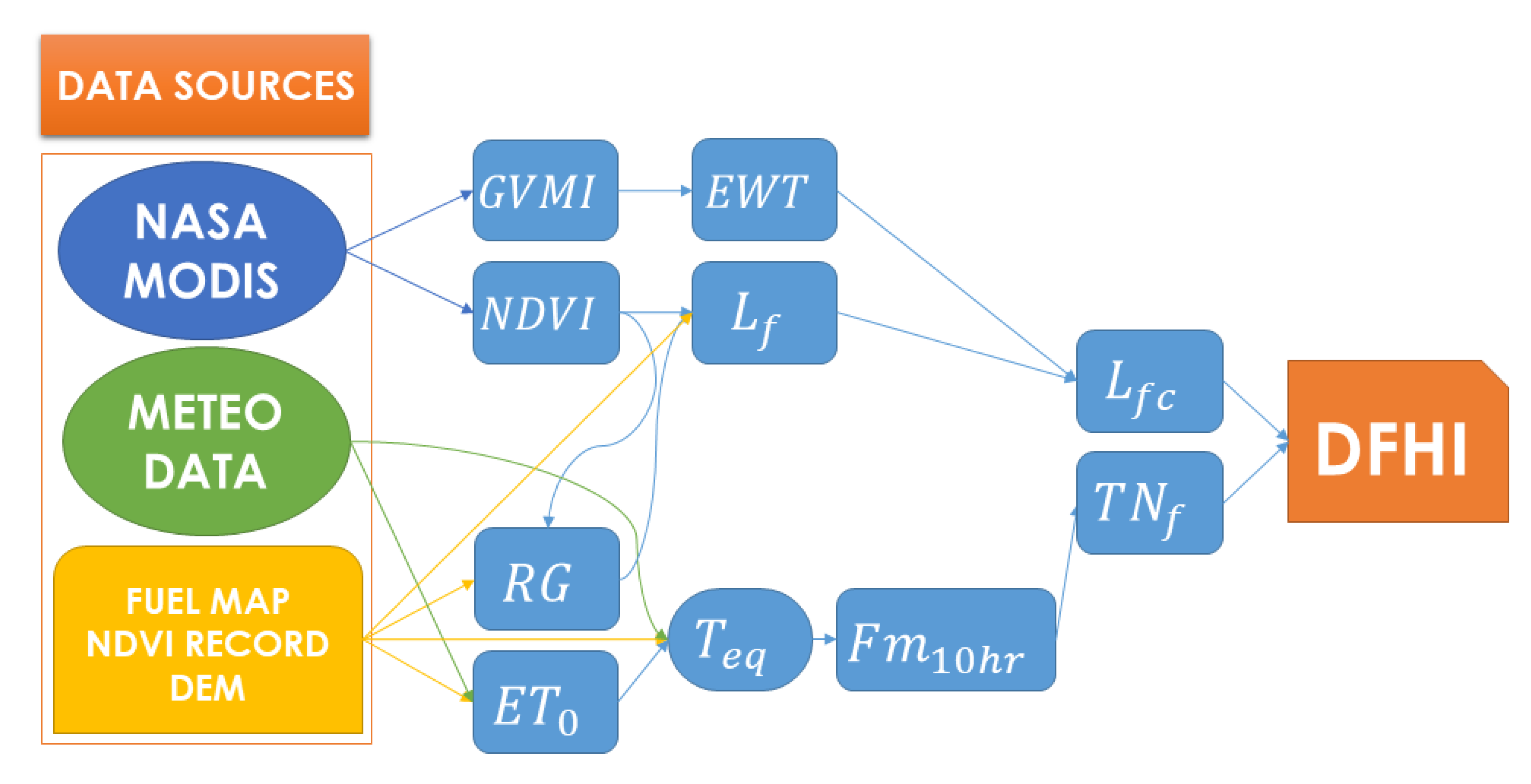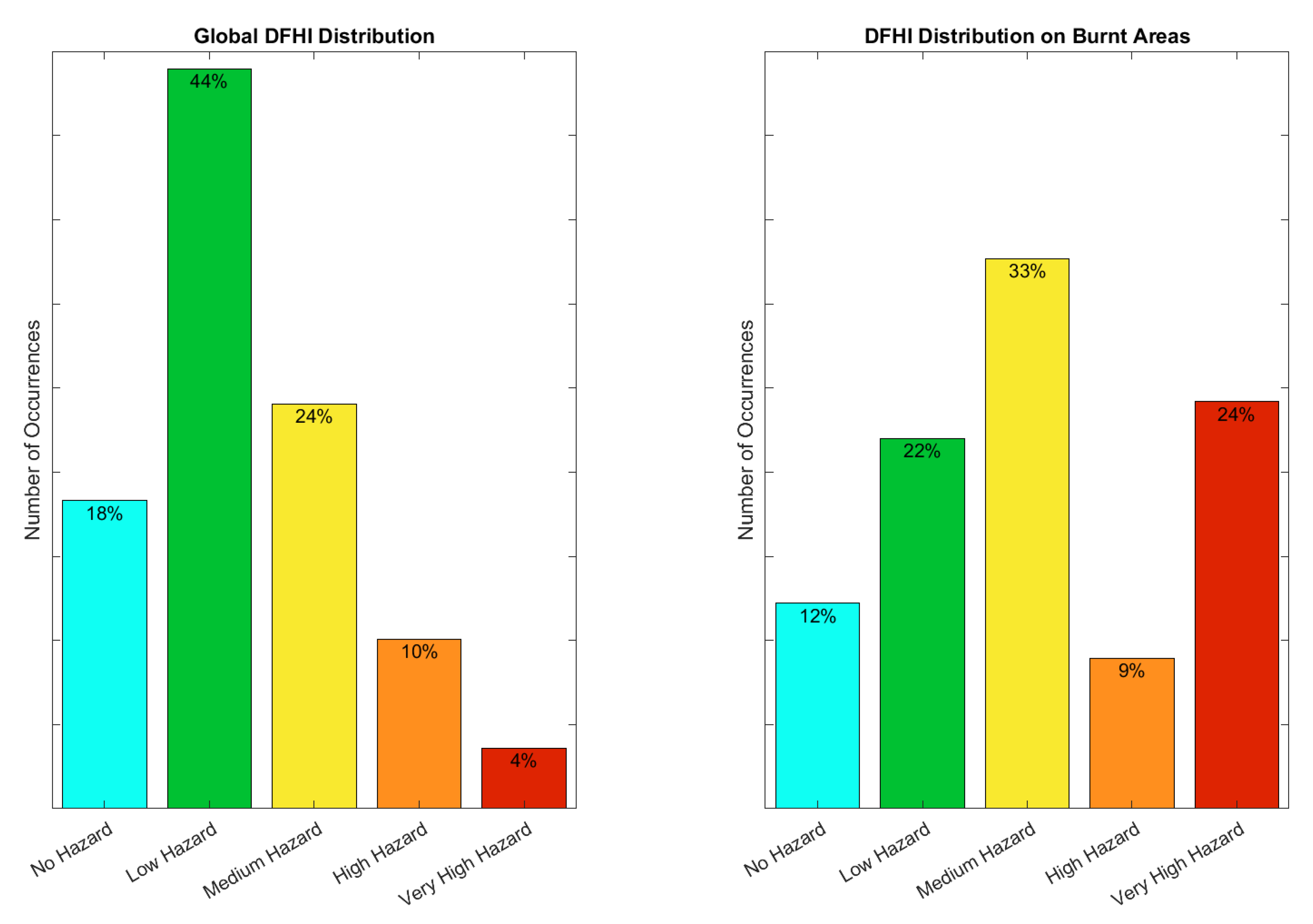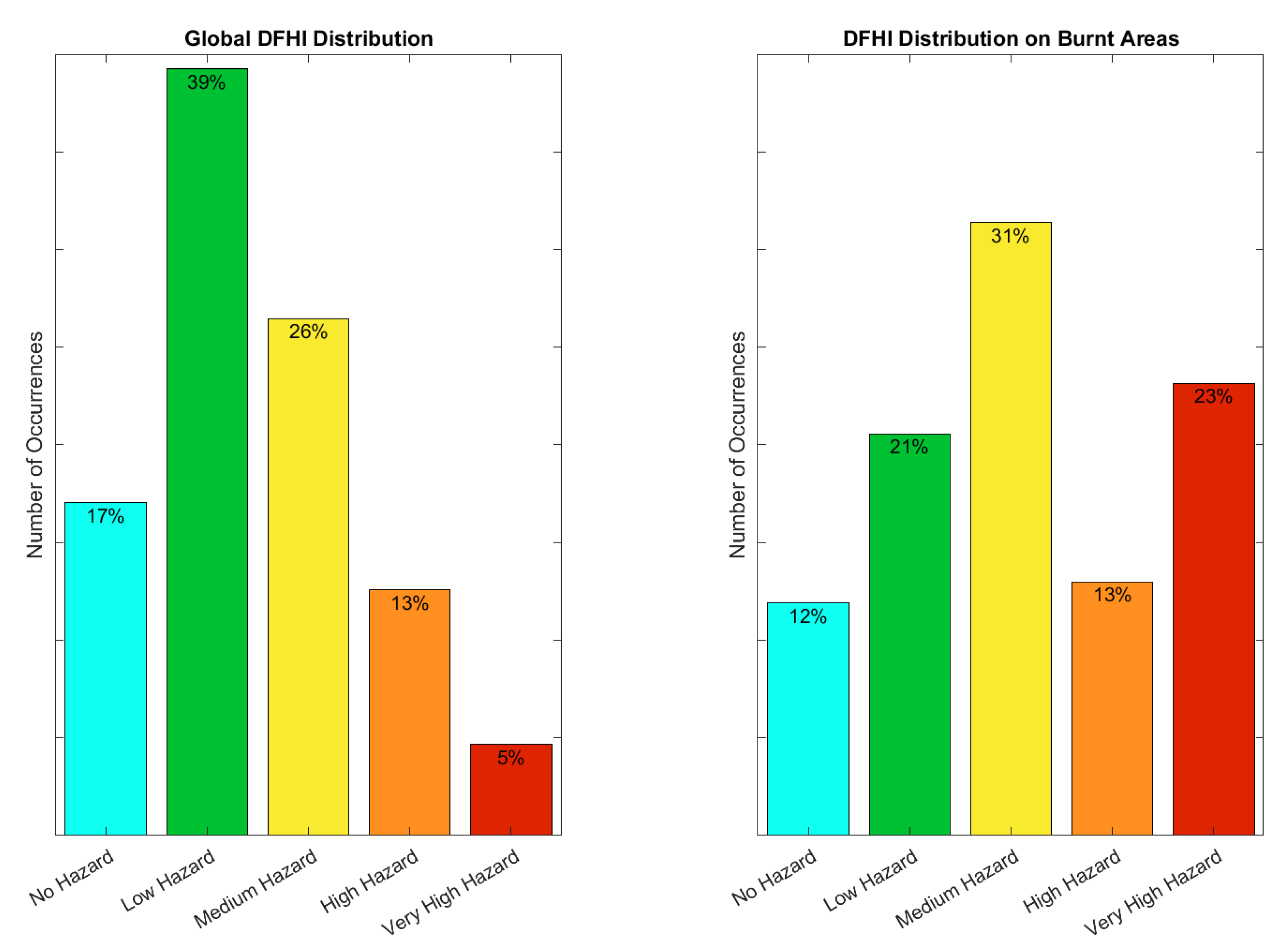The Daily Fire Hazard Index: A Fire Danger Rating Method for Mediterranean Areas
Abstract
1. Introduction
1.1. Methods of Fire Risk Estimate
- Statistical or structural methods (long-term fire risk indices), which define forecast models based on the utilization of slowly changing parameters like topography, vegetation type, or other variables that can be considered constant along the year, and statistical information on the frequency of the phenomenon;
- Dynamical methods (short-term fire risk indices) based on data measured continuously (i.e., daily), on the characteristics of territorial data (orography and vegetation), and on forecast models of meteorological parameters.Typical hazard maps obtained using statistical and dynamical methods are shown in Figure 1.
1.2. State of the Art
1.3. The Role of Remote Sensing in Fire Hazard Assessment
1.4. The Daily Fire Hazard Index
- The estimate of the moisture content in live vegetation;
- The introduction of the local solar aspect effect;
- The introduction of the effect of the wind in increasing the vegetation proneness to burn.
2. The DFHI Algorithm
2.1. Data Sources
2.2. The DFHI Equation and the Hazard Classes
- fraction of live vegetation (dimensionless);
- fraction of ten-hours timelag fuel moisture (dimensionless).
2.3. Estimation of the Live Vegetation Fraction
2.4. Modeling of the Effect of the Wind through the Evapotranspiration
- reference evapotranspiration [mm day];
- net radiation at the crop surface [MJ m day];
- G soil heat flux density [MJ m day];
- T mean daily air temperature at 2 m height [C];
- wind speed at 2 m height [m s];
- saturation vapour pressure [kPa];
- actual vapour pressure [kPa]
- saturation vapour pressure deficit [kPa];
- slope vapour pressure curve [kPa C];
- psychrometric constant [kPa C].
- If the wind speed is lower than 20 m/s and the temperature difference is higher than 15 C, only a 15 C correction is applied. This is done in order to account for the fact that, even though evapotranspiration tends to increase the temperature of the vegetation, air always tends to circulate, and therefore a larger correction would be unrealistic;
- If the temperature difference is lower than −15 C, only a −15 C correction is applied regardless of the wind speed.
3. Results
4. Discussion
Conclusions and Future Developments
Author Contributions
Funding
Conflicts of Interest
Abbreviations
| AOI | Area of Interest |
| ASI | Agenzia Spaziale Italiana |
| CFFDRS | Canadian Forest Fire Danger Rating System |
| CFWIS | Canadian Fire Weather Index System |
| CNR | Consiglio Nazionale delle Ricerche |
| DFHI | Daily Fire Hazard Index |
| ECMWF | European Centre for Medium-Range Weather Forecasts |
| EOSIAL | Earth Observation Satellite Images Applications Lab |
| EFFIS | European Forest Fire Information System |
| EWT | Equivalent Water Thickness |
| FAO | Food and Agriculture Organization |
| FFDI | Forest Fire Danger Index |
| FBP | Fire Behaviour Prediction |
| FPI | Fire Potential Index |
| FWI | Fire Weather Index |
| GEFF | Global ECMWF Fire Forecasting |
| GFDI | Grassland Fire Danger Index |
| GVMI | Global Vegetation Moisture Index |
| IBIMET | Istituto di BIoMETeorologia |
| IFS | Integrated Forecasting System |
| JRC | Joint Research Center |
| LAM | Limited Area Model |
| MFDI | Midterm Fire Danger Index |
| NFDRS | National Fire Danger Rating System |
| NWP | Numerical Weather Prediction |
| NDVI | Normalized Difference Vegetation Index |
| PREFER | Space-based information support for the Prevention and Recovery of Forest Fires Emergency |
| in the Mediterranean Area | |
| RG | Relative Greenness |
| RISICO | RISchio Incendi e COordinamento |
| S2IGI | Sistema Satellitare Integrato di Gestione Incendi |
| SIA | Scuola di Ingegneria Aerospaziale |
| SIGRI | Sistema Integrato per la Gestione del Rischio Incendi |
| WUI | Wildland Urban Interface |
References
- San-Miguel-Ayanz, J.; Durrant, T.; Boca, R.; Libertà, G.; Boccacci, F.; Leo, M.D.; Pérez, J.L.; Schulte, E. Forest Fires in Europe, Middle East and North Africa 2015; Publications Office of the European Union: Luxembourg, 2015. [Google Scholar]
- San-Miguel-Ayanz, J.; Durrant, T.; Boca, R.; Libertà, G.; Branco, A.; Rigo, D.D.; Ferrari, D.; Maianti, P.; Vivancos, T.A.; Schulte, E.; et al. Forest Fires in Europe, Middle East and North Africa 2016; Publications Office of the European Union: Luxembourg, 2016. [Google Scholar]
- San-Miguel-Ayanz, J.; Durrant, T.; Boca, R.; Libertà, G.; Branco, A.; De Rigo, D.; Ferrari, D.; Maianti, P.; Vivancos, T.A.; Costa, H.; et al. Forest Fires in Europe, Middle East and North Africa 2017; Publications Office of the European Union: Luxembourg, 2017. [Google Scholar]
- San-Miguel-Ayanz, J.; Durrant, T.; Boca, R.; Libertà, G.; Branco, A.; De Rigo, D.; Ferrari, D.; Maianti, P.; Vivancos, T.A.; Oom, D.; et al. Forest Fires in Europe, Middle East and North Africa 2018; Publications Office of the European Union: Luxembourg, 2018. [Google Scholar]
- Nurjanatech. S2IGI—Sistema Satellitare Integrato Gestione Incendi. Available online: http://www.nurjanatech.com/work/research-development/s2igi/ (accessed on 21 July 2020).
- Laneve, G.; Cadau, E. Quality assessment of the fire hazard forecast based on a fire potential index for the Mediterranean area by using a MSG/SEVIRI based fire detection system. In Proceedings of the 2007 IEEE International Geoscience and Remote Sensing Symposium, Barcelona, Spain, 23–28 July 2007; pp. 2447–2450. [Google Scholar]
- Schunk, C.; Wastl, C.; Leuchner, M.; Menzel, A. Fine fuel moisture for site-and species-specific fire danger assessment in comparison to fire danger indices. Agric. For. Meteorol. 2017, 234, 31–47. [Google Scholar] [CrossRef]
- Van Wagner, C.E.; Forest, P. Development and Structure of the Canadian Forest Fireweather Index System; Forestry Technical Report; Canadian Forestry Service: Ottawa, ON, Canada, 1987.
- Burgan, R. Revisions to the 1978 National Fire-Danger Rating System; Research Paper RP-SE-273; US Department of Agriculture, Forest Service, Southeastern Forest Experiment Station: Asheville, NC, USA, 1988.
- Cohen, J.D. The National Fire-Danger Rating System: Basic Equations; US Department of Agriculture, Forest Service, Pacific Southwest Forest and Range Experiment Station: Berkeley, CA, USA, 1985; Volume 82.
- Nesterov, V. Flammability of the Forest and Methods for Its Determination, (Gorimost lesa i metodi eio opredelenia); Goslesbumizdat, USSR State Ind. Press: Moscow, Russia, 1949. [Google Scholar]
- Fiorucci, P.; Gaetani, F.; Minciardi, R.; Trasforini, E. Forest fire dynamic hazard assessment and pre-operational resource allocation. IFAC Proc. Vol. 2005, 38, 91–96. [Google Scholar] [CrossRef]
- Fujioka, F.; Gill, A.; Viegas, D.; Wotton, B. Fire danger and fire behavior modeling systems in Australia, Europe, and North America. In Wildland Fires and Air Pollution: Developments in Environmental Science; Bytnerowicz, A., Arbaugh, M., Andersen, C., Riebau, A., Eds.; Elsevier: Amsterdam, The Netherlands, 2009; pp. 471–497. [Google Scholar]
- McArthur, A.G. Weather and Grassland Fire Behaviour; Forestry and Timber Bureau, Department of National Development: Canberra, Australia, 1967. [Google Scholar]
- McArthur, A.G. Fire Behaviour in Eucalypt Forests; Forestry and Timber Bureau, Department of National Development: Canberra, Australia, 1967. [Google Scholar]
- Keetch, J.J.; Byram, G.M. A Drought Index for Forest Fire Control; US Department of Agriculture, Forest Service, Southeastern Forest Experiment Station: Asheville, NC, USA, 1968; Volume 38.
- Noble, I.; Gill, A.; Bary, G. McArthur’s fire-danger meters expressed as equations. Aust. J. Ecol. 1980, 5, 201–203. [Google Scholar] [CrossRef]
- Stocks, B.J.; Lynham, T.; Lawson, B.; Alexander, M.; Wagner, C.V.; McAlpine, R.; Dube, D. Canadian forest fire danger rating system: An overview. For. Chron. 1989, 65, 258–265. [Google Scholar] [CrossRef]
- Forestry Canada, Fire Danger Group and Science and Sustainable Development Directorate. Development and Structure of the Canadian Forest Fire Behavior Prediction System; Forestry Canada, Science and Sustainable Development Directorate: Ottawa, ON, Canada, 1992; Volume 2.
- San-Miguel-Ayanz, J.; Barbosa, P.; Schmuck, G.; Libertà, G.; Meyer-Roux, J. The European Forest Fire Information System. In Proceedings of the 6th AGILE, Lyon, France, 24–26 April 2003; pp. 24–26. [Google Scholar]
- Gonçalves, Z.; Lourenço, L. Meteorological Index of Forest Fire Risk in the Portuguese Mainland Territory. In Proceedings of the International Conference on Forest Fire Research, Coimbra, Portugal, 19–22 November 1990; pp. 1–14. [Google Scholar]
- Velez, R. Manual de Operaciones Contra Incendios Forestales; Min. Agricultura, ICONA: Madrid, Spain, 1993. [Google Scholar]
- Drouet, J.C. Mise au Point d’un Indice Numérique de Risque Météorologique d’incendies de Forêts. Dossier: Forêts et Incendies 1991–1992; Association Forêt méditerranéenne: Marseille, France, 1993. [Google Scholar]
- Ventura, F.; Marletto, V.; Zinoni, F. Un metodo per il calcolo dell’indice meteorologico del rischio di incendio forestale. Sherwood 2001, 68, 13–18. [Google Scholar]
- Rothermel, R.C. Modeling Moisture Content of Fine Dead Wildland Fuels: Input to the BEHAVE Fire Prediction System; Number 359; US Department of Agriculture, Forest Service, Intermountain Research Station: Ogden, UT, USA, 1986.
- Burgan, R.E. Monitoring Vegetation Greenness with Satellite Data; US Department of Agriculture, Forest Service, Intermountain Research Station: Ogden, UT, USA, 1993; Volume 297.
- Burgan, R.; Klaver, R.W.; Klaver, J.M. Fuel models and fire potential from satellite and surface observations. Int. J. Wildland Fire 1998, 8, 159–170. [Google Scholar] [CrossRef]
- Fiorucci, P.; Gaetani, F.; Minciardi, R. Development and application of a system for dynamic wildfire risk assessment in Italy. Environ. Model. Softw. 2008, 23, 690–702. [Google Scholar] [CrossRef]
- ANYWHERE Project: Innovating the Management of Weather Emergencies. RISICO—Fire Danger Rating System. 2020. Available online: http://anywhere-h2020.eu/ (accessed on 21 July 2020).
- Szpakowski, D.M.; Jensen, J.L. A Review of the Applications of Remote Sensing in Fire Ecology. Remote Sens. 2019, 11, 2638. [Google Scholar] [CrossRef]
- Chuvieco, E.; Congalton, R.G. Application of remote sensing and geographic information systems to forest fire hazard mapping. Remote Sens. Environ. 1989, 29, 147–159. [Google Scholar] [CrossRef]
- Adab, H.; Kanniah, K.D.; Solaimani, K. Modeling forest fire risk in the northeast of Iran using remote sensing and GIS techniques. Nat. Hazards 2013, 65, 1723–1743. [Google Scholar] [CrossRef]
- Yu, B.; Chen, F.; Li, B.; Wang, L.; Wu, M. Fire risk prediction using remote sensed products: A case of Cambodia. Photogramm. Eng. Remote Sens. 2017, 83, 19–25. [Google Scholar] [CrossRef]
- Arroyo, L.A.; Pascual, C.; Manzanera, J.A. Fire models and methods to map fuel types: The role of remote sensing. For. Ecol. Manag. 2008, 256, 1239–1252. [Google Scholar] [CrossRef]
- Giglio, L.; Csiszar, I.; Restás, Á.; Morisette, J.T.; Schroeder, W.; Morton, D.; Justice, C.O. Active fire detection and characterization with the advanced spaceborne thermal emission and reflection radiometer (ASTER). Remote Sens. Environ. 2008, 112, 3055–3063. [Google Scholar] [CrossRef]
- Schroeder, W.; Oliva, P.; Giglio, L.; Csiszar, I.A. The New VIIRS 375 m active fire detection data product: Algorithm description and initial assessment. Remote Sens. Environ. 2014, 143, 85–96. [Google Scholar] [CrossRef]
- Xu, G.; Zhong, X. Real-time wildfire detection and tracking in Australia using geostationary satellite: Himawari-8. Remote Sens. Lett. 2017, 8, 1052–1061. [Google Scholar] [CrossRef]
- Di Biase, V.; Laneve, G. Geostationary sensor based forest fire detection and monitoring: An improved version of the SFIDE algorithm. Remote Sens. 2018, 10, 741. [Google Scholar] [CrossRef]
- Laneve, G.; Santilli, G.; Luciani, R. Improving SEVIRI-Based Hotspots Detection by Using Multiple Simultaneous Observations. IEEE J. Sel. Top. Appl. Earth Obs. Remote Sens. 2019, 12, 2349–2356. [Google Scholar] [CrossRef]
- Roy, D.P.; Boschetti, L.; Justice, C.; Ju, J. The collection 5 MODIS burned area product—Global evaluation by comparison with the MODIS active fire product. Remote Sens. Environ. 2008, 112, 3690–3707. [Google Scholar] [CrossRef]
- Randerson, J.; Chen, Y.; Werf, G.V.D.; Rogers, B.; Morton, D. Global burned area and biomass burning emissions from small fires. J. Geophys. Res. Biogeosci. 2012, 117. [Google Scholar] [CrossRef]
- Roy, D.P.; Boschetti, L.; Trigg, S.N. Remote sensing of fire severity: Assessing the performance of the normalized burn ratio. IEEE Geosci. Remote Sens. Lett. 2006, 3, 112–116. [Google Scholar] [CrossRef]
- Miller, J.D.; Thode, A.E. Quantifying burn severity in a heterogeneous landscape with a relative version of the delta Normalized Burn Ratio (dNBR). Remote Sens. Environ. 2007, 109, 66–80. [Google Scholar] [CrossRef]
- Fernández-Manso, A.; Fernández-Manso, O.; Quintano, C. SENTINEL-2A red-edge spectral indices suitability for discriminating burn severity. Int. J. Appl. Earth Obs. Geoinf. 2016, 50, 170–175. [Google Scholar] [CrossRef]
- Veraverbeke, S.; Gitas, I.; Katagis, T.; Polychronaki, A.; Somers, B.; Goossens, R. Assessing post-fire vegetation recovery using red–near infrared vegetation indices: Accounting for background and vegetation variability. ISPRS J. Photogramm. Remote Sens. 2012, 68, 28–39. [Google Scholar] [CrossRef]
- Stefanidou, A.; Gitas, I.; Stavrakoudis, D.; Eftychidis, G. Midterm Fire Danger Prediction Using Satellite Imagery and Auxiliary Thematic Layers. Remote Sens. 2019, 11, 2786. [Google Scholar] [CrossRef]
- Qin, X.L.; Zhang, Z.H.; Li, Z.Y.; Yi, H.R. Forecasting method of national-level forest fire risk rating. In Remote Sensing of the Environment: 16th National Symposium on Remote Sensing of China; Tong, Q., Ed.; International Society for Optics and Photonics, SPIE: Bellingham, WA, USA, 2008; Volume 7123, pp. 328–334. Available online: https://www.spiedigitallibrary.org/conference-proceedings-of-spie/7123/1/Forecasting-method-of-national-level-forest-fire-risk-rating/10.1117/12.816205.short?SSO=1 (accessed on 21 July 2020). [CrossRef]
- Chuvieco, E.; Aguado, I.; Jurdao, S.; Pettinari, M.L.; Yebra, M.; Salas, J.; Hantson, S.; Riva, J.; Ibarra, P.; Rodrigues, M.; et al. Integrating geospatial information into fire risk assessment. Int. J. Wildland Fire 2014, 23, 606–619. [Google Scholar] [CrossRef]
- Fiorucci, P.; Gaetani, F.; Lanorte, A.; Lasaponara, R. Dynamic Fire Danger Mapping from Satellite Imagery and Meteorological Forecast Data. Earth Interact. 2009, 11, 1–17. [Google Scholar] [CrossRef]
- Lim, C.H.; Kim, Y.S.; Won, M.; Kim, S.J.; Lee, W.K. Can satellite-based data substitute for surveyed data to predict the spatial probability of forest fire? A geostatistical approach to forest fire in the Republic of Korea. Geomat. Nat. Hazards Risk 2019, 10, 719–739. [Google Scholar] [CrossRef]
- Dymond, C.C.; Field, R.; Roswintiarti, O.; Guswanto. Using satellite fire detection to calibrate components of the fire weather index system in Malaysia and Indonesia. Environ. Manag. 2005, 35, 426–440. [Google Scholar] [CrossRef]
- Laneve, G.; Fusilli, L.; Bernini, G.; Beltran, J.S. Preventing Forest Fires Through Remote Sensing: Achievements of the Prevention and Recovery of Forest Fires Emergency in the Mediterranean Area project. IEEE Geosci. Remote Sens. Mag. 2020. [Google Scholar] [CrossRef]
- Tedim, F.; Xanthopoulos, G.; Leone, V. Chapter 5—Forest Fires in Europe: Facts and Challenges. In Wildfire Hazards, Risks and Disasters; Elsevier: Amsterdam, The Netherlands, 2015; pp. 77–99. [Google Scholar] [CrossRef]
- Amatulli, G.; Camia, A. Exploring the Relationships of Fire Occurrence Variables by Means of CART and MARS Models; Joint Research Centre, Institute for Environment and Sustainability: Ispra, Italy, 2008. [Google Scholar]
- López, A.S.; San-Miguel-Ayanz, J.; Burgan, R.E. Integration of satellite sensor data, fuel type maps and meteorological observations for evaluation of forest fire risk at the pan-European scale. Int. J. Remote Sens. 2002, 23, 2713–2719. [Google Scholar] [CrossRef]
- European Commission. European Forest Fire Information System. Available online: https://effis.jrc.ec.europa.eu/ (accessed on 21 July 2020).
- Nelson, R.M., Jr. Prediction of diurnal change in 10-h fuel stick moisture content. Can. J. For. Res. 2000, 30, 1071–1087. [Google Scholar] [CrossRef]
- Laneve, G.; Munzer, J.; Fabrizio, F.F.; Hirn, B.; Battazza, F.; Fusilli, L.; De Bonis, R. SIGRI project: Products validation results. IEEE J. Sel. Top. Appl. Earth Obs. Remote Sens. 2013, 7, 895–905. [Google Scholar] [CrossRef]
- Laneve, G.; Fusilli, L. High Resolution Fire Hazard Index Based on Satellite Images. Territorium 2019, 26, 29–41. [Google Scholar] [CrossRef]
- Laneve, G.; Jahjah, M.; Ferrucci, F.; Battazza, F. SIGRI Project: The Development of the Fire Vulnerability Index. ISPRS Int. Soc. Photogramm. Remote Sens. 2011. [Google Scholar] [CrossRef]
- Ceccato, P.; Gobron, N.; Flasse, S.; Pinty, B.; Tarantola, S. Designing a spectral index to estimate vegetation water content from remote sensing data: Part 1: Theoretical approach. Remote Sens. Environ. 2002, 82, 188–197. [Google Scholar] [CrossRef]
- Fosberg, M.A. Forecasting the 10-Hour Timelag Fuel Moisture; U.S. Department of Agriculture, Forest Service, Rocky Mountain Forest Range Experiment Station: Fort Collins, CO, USA, 1977; Volume 187.
- Allen, R.G.; Pereira, L.S.; Raes, D.; Smith, M. FAO Irrigation and Drainage Paper No. 56; Food and Agriculture Organization of the United Nations: Rome, Italy, 1998. [Google Scholar]
- Rothermel, R.C. A Mathematical Model for Predicting Fire Spread in Wildland Fuels; Intermountain Forest & Range Experiment Station, Forest Service: Ogden, UT, USA, 1972; Volume 115. [Google Scholar]
- Salis, M.; Ager, A.A.; Arca, B.; Finney, M.A.; Bacciu, V.; Duce, P.; Spano, D. Assessing exposure of human and ecological values to wildfire in Sardinia, Italy. Int. J. Wildland Fire 2013, 22, 549–565. [Google Scholar] [CrossRef]




| Dataset | Data Type | Resolution [m] | Provider | Date/Frequency |
|---|---|---|---|---|
| SAR-derived DEM | Raster | 10 | Regione Sardegna | 2011 |
| NDVI Record | Raster | 250 | - | 2014–2019 |
| Fuel Map | Shapefile | - | JRC | 2013 |
| MOD09GA Images | Raster | 500 | NASA LAADS DAAC | Daily |
| MOD09GQ Images | Raster | 250 | NASA LAADS DAAC | Daily |
| Meteo Data | Raster | 3000 | WRF | Daily |
| Product | HDF Layer | Description | Resolution [m] | Wavelength [nm] |
|---|---|---|---|---|
| MOD09GQ | sur_refl_b01_1 | Surface Reflectance Band 1 | 250 | 620–690 |
| MOD09GQ | sur_refl_b02_1 | Surface Reflectance Band 2 | 250 | 841–876 |
| MOD09GA | sur_refl_b02_1 | Surface Reflectance Band 2 | 500 | 841–876 |
| MOD09GA | sur_refl_b06_1 | Surface Reflectance Band 6 | 500 | 1628–1652 |
| DFHI Interval | Hazard Class |
|---|---|
| 0–20 | No Hazard |
| 20–40 | Low Hazard |
| 40–55 | Medium Hazard |
| 55–70 | High Hazard |
| 70–100 | Very High Hazard |
© 2020 by the authors. Licensee MDPI, Basel, Switzerland. This article is an open access article distributed under the terms and conditions of the Creative Commons Attribution (CC BY) license (http://creativecommons.org/licenses/by/4.0/).
Share and Cite
Laneve, G.; Pampanoni, V.; Uddien Shaik, R. The Daily Fire Hazard Index: A Fire Danger Rating Method for Mediterranean Areas. Remote Sens. 2020, 12, 2356. https://doi.org/10.3390/rs12152356
Laneve G, Pampanoni V, Uddien Shaik R. The Daily Fire Hazard Index: A Fire Danger Rating Method for Mediterranean Areas. Remote Sensing. 2020; 12(15):2356. https://doi.org/10.3390/rs12152356
Chicago/Turabian StyleLaneve, Giovanni, Valerio Pampanoni, and Riyaaz Uddien Shaik. 2020. "The Daily Fire Hazard Index: A Fire Danger Rating Method for Mediterranean Areas" Remote Sensing 12, no. 15: 2356. https://doi.org/10.3390/rs12152356
APA StyleLaneve, G., Pampanoni, V., & Uddien Shaik, R. (2020). The Daily Fire Hazard Index: A Fire Danger Rating Method for Mediterranean Areas. Remote Sensing, 12(15), 2356. https://doi.org/10.3390/rs12152356





